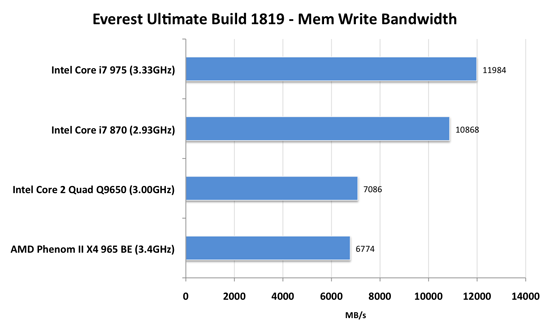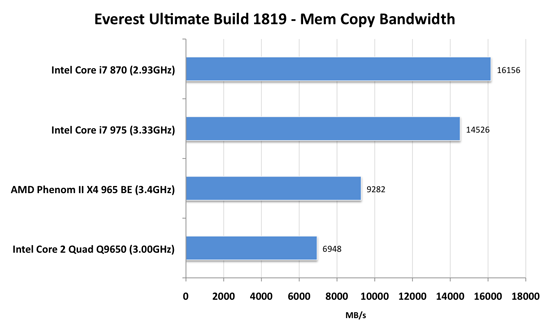Intel's Core i7 870 & i5 750, Lynnfield: Harder, Better, Faster Stronger
by Anand Lal Shimpi on September 8, 2009 12:00 AM EST- Posted in
- CPUs
Discovery: Two Channels Aren't Worse Than Three
Intel told me something interesting when I was out in LA earlier this summer: it takes at least 3 cores to fully saturate Lynnfield's dual-channel DDR3-1333 memory bus. That's three cores all working on memory bandwidth intensive threads at the same time. That's a pretty stiff requirement. In the vast, vast majority of situations Lynnfield's dual channel DDR3 memory controller won't hurt it.
Move up to 6 or 8 core designs and a third memory channel is necessary, and that's why we'll see those processors debut exclusively on LGA-1366 platforms. In fact, X58 motherboards will only need a BIOS update to work with the 6-core 32nm Gulftown processor next year. P55 looks like it'll be limited to four cores and below.
Because of this, Lynnfield's memory bandwidth and latency cores are actually quite similar to Bloomfield. I used Everest to look at memory bandwidth and latency between a Core i7 975 and Core i7 870 (Lynnfield):

Lynnfield's memory controller is good, easily as good as what's in Bloomfield if not slightly better.



Both processors turbo'd up to 3.46GHz, indicating that Everest's memory test uses no more than two threads. The 975 ran DDR3-1066 memory (the highest it officially supports), while the 870 used DDR3-1333. The faster memory gave the 870 the advantage. Since we're not taxing all four cores, Lynnfield is at no disadvantage from a bandwidth perspective. Surprisingly enough, even SiSoft Sandra (which does use four cores for its memory bandwidth test) shows Lynnfield's dual-channel DDR3-1333 memory controller as equal to Bloomfield's triple-channel DDR3-1066 interface.
| SiSoft Sandra 2009.SP4 | Intel Core i7 975 | Intel Core i7 870 |
| Aggregate Memory Bandwidth | 17.8 GB/s | 17.3 GB/s |
Long story short? Lynnfield won't be memory bandwidth limited with DDR3-1333 for the overwhelming majority of usage cases.










343 Comments
View All Comments
goinginstyle - Thursday, September 10, 2009 - link
What is worthless here is your continued ramblings about subjects you have no actual knowledge of right now. Do you own a P55 system? If so, let's see an article from you. Really, you come over spouting off and calling everyone idiots, yet, you we do not see any articles from you at Toms about the subject matter. In fact, we do not see any comments from you anywhere else about P55. Toms, Tech Report, and AT all came to the same conclusion, presented the same type of information (although AT discussed subjects like PCIE), and yet you do not comment on those other websites.Either you are posting here because you think your negative posts will somehow get you attention that your mother never gave you or you are doing to try and look important to the people in charge at Toms. I hope to God that they never allow you to post another piece of garbage on their site. Really, that article was a straight copy and paste from several other articles on the subject along with Wikipedia information. I am surprised you were not sued for plagiarism, maybe you were and that is why you are over here.
So far, all of your ramblings have only proved your total lack of intelligence when it comes to computer components. Once again, when will we see you making comments on Toms about their similar coverage or when can you expect to see your expert PP article on the site?
eternalfantasy - Tuesday, September 8, 2009 - link
Fully agree up to the AMD part. This is the most biased review I've seen published by Anandtech to date. I think a "Buy me now!" link at the end of the article with an Intel sponsored Ad will complete the article perfectly.Stock clock speed CPU review is what highstreet mags for average Joes write about. Excluding what's importent for readers of tech sites, such as:
Clock for clock comparison
Maximum overclock with similer priced CPU/platform
is just blatent attempt at glorifying Intel's mainstream platform to look like more then what it really is. A cheaper mainstream alternative to the X58 that has been avaliable over a year ago.
PassingBy - Tuesday, September 8, 2009 - link
As released, Core i5 and 1156 Core i7 have no IGP market, so presumably people reading this review will have no interest in using an IGP.In any case, we can safely say that your prognostications like 'a brain dead platform for brain dead people' were total bullshit, as many people tried to tell you. Now, many more people can place a Nehalem-based system on their list of possible purchases. Clarkdale will extend Nehalem/Westmere to even lower price points (and yes, then you can start comparing IGPs, if you like).
TA152H - Tuesday, September 8, 2009 - link
You're really confused.Honestly, anyone who knows anything about computers would be pretty stupid to get this platform. It's fine stock, but when you throw in overclock, the i7 920 is the better choice.
But, here's your hypocrisy. This article was main for mainstream people, since there's no overclocking comparisons, really. The IGP is what makes AMD work, and they do sell their processors into this market. Anand was commenting on how AMD had to lower their prices, so within this context the entire market is applicable. You didn't understand the context, did you?
I didn't say the platform was brain-dead, although you seem to be. I said it was brain-damaged. It's a Celeron. If you look at the reviews from better sites, you can see the Bloomfield running at the same speed is faster than the brain-damaged Lynnfield. Anand really tried to obfuscate this, by using bad comparisons or those meant to show the Lynnfield in the best light, instead of just presenting the most useful information. He fooled you, because you're a moron, but not everyone.
I do like this site, or I did, but I'm really getting unnerved by the way they test to show what they want to show, instead of test and then make up their minds. It's really problematic, and it's going to bite them when more people figure this out.
imperialsoren - Tuesday, September 8, 2009 - link
You have a nasty way of conversing.IdolObserver - Wednesday, September 9, 2009 - link
It's not only his nasty way of conversing. He also doesn't have a clue what he is talking about.Zymon - Tuesday, September 8, 2009 - link
I agree in the main part - there are many aspects which seem to have been completely ignored in this, and many other reviews of Lynnfield.It seems strange that you haven't used a level playing field between compared systems: ALL 3 platforms can use DDR3 - you've used X48 for Core 2 chips, but apparently used different RAM than i5. Why on earth have you used an AM2+ board and DDR2 ram for AMD? I guess it's *only* been 9 months since AM3 became available?
As mentioned, a true clock-for-clock comparison would be VERY interesting, using the same RAM, at the same speeds and timings between platforms.
Anand Lal Shimpi - Tuesday, September 8, 2009 - link
Sorry if this wasn't made clear in the review but the Phenom II X4 965 BE used the same test platform as our review of that CPU: an AM3 motherboard with DDR3 memory.I'm out of the office now but I'll update the test tables later this evening to reflect this.
Take care,
Anand
Zymon - Tuesday, September 8, 2009 - link
Cheers for the clarification Anand!- It seemed unusual for one of your articles, hence the comment!
Laters..
snakeoil - Tuesday, September 8, 2009 - link
i want to know if those benchmarks were with the turbo enabled, which would be cheating, because that's overclocking.for every benchmark turbo must be disabled to be fair.
readers are not stupid.